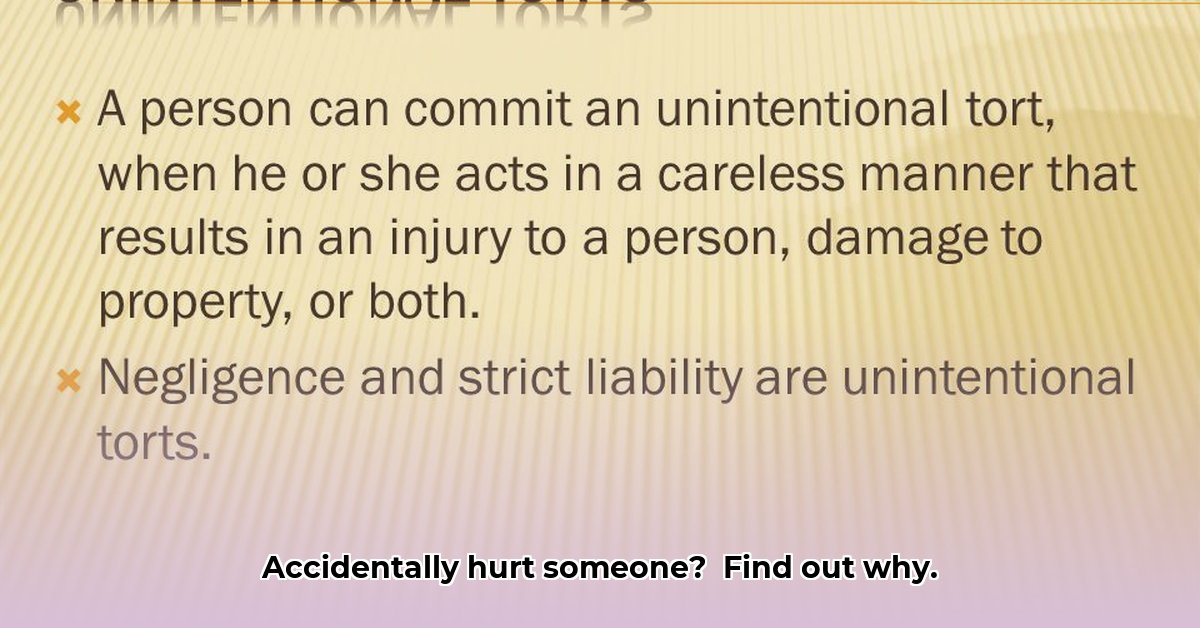
Ever accidentally hurt someone, or been hurt by someone's mistake? This guide explains the legal side of accidents – specifically, unintentional torts, like negligence. We'll explain negligence in plain English, show you how to prove negligence, and outline steps to take if you're involved, whether you caused the accident or were injured. This isn't legalese; it's straightforward advice to help you understand your rights.
What is an Unintentional Tort?
Unintentional torts are accidents with legal consequences. The most common is negligence – someone wasn't careful enough, causing harm. Imagine tripping over a carelessly placed cable and breaking your arm; that’s a potential negligence case. But let's delve deeper.
Understanding Negligence: The Foundation of Accidental Harm
Negligence requires proving four elements:
Duty of Care: Did the person have a responsibility to act reasonably and avoid hurting you? (This duty exists when someone's actions could reasonably affect others' safety). Drivers owe a duty to drive safely; store owners must ensure safe premises.
Breach of Duty: Did that person fail to meet their responsibility? Did they act unreasonably? We judge this against a "reasonable person" standard – what would a careful, average person do? Actions below that standard may constitute a breach.
Causation: Did their careless actions directly lead to your injuries? This is often established by asking: "But for" their actions, would you have been hurt? If the answer is no, a direct link exists.
Damages: Were you harmed? This includes physical injuries, medical bills, lost wages, emotional distress, or property damage. You'll need documentation to prove your losses.
Did you know that proving causation is often the most challenging aspect of a negligence case? It requires demonstrating a clear, unbroken chain of events linking the defendant's actions to the plaintiff's injuries.
Beyond Carelessness: Other Types of Unintentional Wrongs
While negligence is common, other unintentional torts exist:
Negligent Infliction of Emotional Distress (NIED): Negligence causing significant emotional trauma (e.g., witnessing a car accident involving someone you know, leading to severe anxiety). Proving NIED is challenging due to the intangible nature of emotional distress.
Strict Liability: Responsibility for harm even without negligence. This applies to defective products (a faulty toaster causing a fire) or unusually hazardous activities (transporting explosives).
How often do you think strict liability cases arise compared to negligence cases? While less frequent than negligence claims, strict liability cases often involve significant damages, making them crucial to understand.
Unintentional vs. Intentional: What's the Difference?
The key difference is intent. Intentional torts are deliberate actions meant to cause harm (e.g., assault and battery). Unintentional torts are rooted in carelessness, not malice.
Getting Compensation for Accidental Injuries
If someone's negligence injured you, you may get compensation. This could include medical costs, lost income, pain and suffering, and more. However, a personal injury lawyer can navigate this complex legal landscape. They help determine your options and protect your rights.
According to the American Bar Association, approximately 95% of personal injury cases are settled out of court. This highlights the importance of negotiation and strategic legal counsel.
Building Your Case: A Practical Guide
Successfully pursuing a claim involves careful preparation. Follow these steps:
Preserve Evidence: Gather medical records, police reports, photos, witness statements, and all relevant information.
Seek Legal Counsel: A personal injury lawyer provides guidance and handles next steps.
File a Claim: Your lawyer handles the paperwork to file your claim.
Negotiate a Settlement: Many cases resolve outside of court through negotiation.
Proceed to Trial (If Necessary): If a settlement can't be reached, your case might go to trial.
"Remember, thorough documentation is key to a successful personal injury claim," says Sarah Miller, Esq., Partner at Miller & Zois, a leading personal injury law firm. "Preserve all evidence, including photos, medical records, and witness statements, to ensure a strong case."
How to Prove Emotional Distress Damages in Negligence Lawsuits
Negligence often causes significant emotional distress. Proving these intangible harms requires concrete evidence. Juries need convincing; your experience must be demonstrable.
Proving Your Case: The Challenges
The invisible nature of emotional distress presents challenges. You need concrete evidence to demonstrate your suffering and its impact on daily life.
What Evidence Do You Need?
Medical Documentation: Therapy records, diagnoses, and prescribed medications are crucial.
Witness Testimony: Statements from those who witnessed your emotional struggle.
Physical Manifestations: Insomnia, appetite changes, or other physical symptoms linked to emotional distress.
Expert Testimony: A mental health professional can opine on the severity and long-term effects.
Documentation of Lost Income: Document lost wages if your emotional distress affected work.
In a study by the American Psychological Association, approximately 75% of individuals suffering from significant emotional distress following a traumatic event sought professional mental health treatment. This highlights the importance of obtaining medical documentation to support your claim.
State Laws Vary
Laws differ by state. Consult a personal injury attorney experienced in emotional distress claims in your state.
Key Takeaways:
- Medical records are paramount.
- Witness accounts add credibility.
- Physical manifestations strengthen your claim.
- Expert testimony lends objective weight.
- Documentation of financial losses quantifies damages.
- State laws vary; consult local counsel.
Remember, this is for educational purposes only and isn't legal advice. Consult a qualified legal professional for your specific situation.